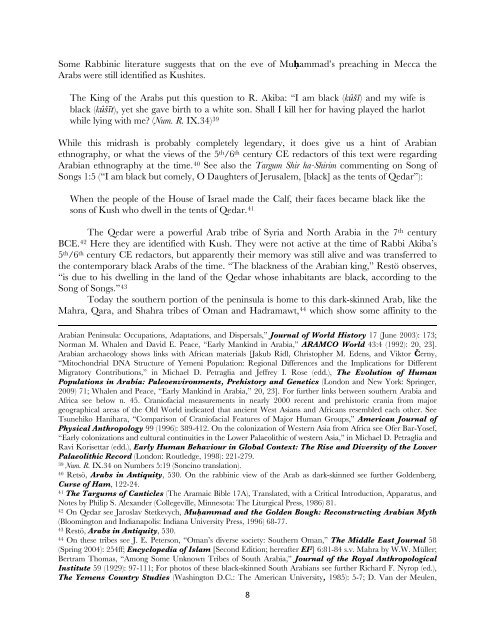“Anyone who says that the Prophet is black should be killed”: The ...
“Anyone who says that the Prophet is black should be killed”: The ...
“Anyone who says that the Prophet is black should be killed”: The ...
Create successful ePaper yourself
Turn your PDF publications into a flip-book with our unique Google optimized e-Paper software.
Some Rabbinic literature suggests <strong>that</strong> on <strong>the</strong> eve of MuÈammad’s preaching in Mecca <strong>the</strong><br />
Arabs were still identified as Kushites.<br />
<strong>The</strong> King of <strong>the</strong> Arabs put th<strong>is</strong> question to R. Akiba: “I am <strong>black</strong> (kûšī) and my wife <strong>is</strong><br />
<strong>black</strong> (kûšīt), yet she gave birth to a white son. Shall I kill her for having played <strong>the</strong> harlot<br />
while lying with me? (Num. R. IX.34) 39<br />
While th<strong>is</strong> midrash <strong>is</strong> probably completely legendary, it does give us a hint of Arabian<br />
ethnography, or what <strong>the</strong> views of <strong>the</strong> 5th /6th century CE redactors of th<strong>is</strong> text were regarding<br />
Arabian ethnography at <strong>the</strong> time. 40 See also <strong>the</strong> Targum Shir ha-Shirim commenting on Song of<br />
Songs 1:5 (“I am <strong>black</strong> but comely, O Daughters of Jerusalem, [<strong>black</strong>] as <strong>the</strong> tents of Qedar”):<br />
When <strong>the</strong> people of <strong>the</strong> House of Israel made <strong>the</strong> Calf, <strong>the</strong>ir faces <strong>be</strong>came <strong>black</strong> like <strong>the</strong><br />
sons of Kush <strong>who</strong> dwell in <strong>the</strong> tents of Qedar. 41<br />
<strong>The</strong> Qedar were a powerful Arab tri<strong>be</strong> of Syria and North Arabia in <strong>the</strong> 7th century<br />
BCE. 42 Here <strong>the</strong>y are identified with Kush. <strong>The</strong>y were not active at <strong>the</strong> time of Rabbi Akiba’s<br />
5th /6th century CE redactors, but apparently <strong>the</strong>ir memory was still alive and was transferred to<br />
<strong>the</strong> contemporary <strong>black</strong> Arabs of <strong>the</strong> time. “<strong>The</strong> <strong>black</strong>ness of <strong>the</strong> Arabian king,” Restö observes,<br />
“<strong>is</strong> due to h<strong>is</strong> dwelling in <strong>the</strong> land of <strong>the</strong> Qedar <strong>who</strong>se inhabitants are <strong>black</strong>, according to <strong>the</strong><br />
Song of Songs.” 43<br />
Today <strong>the</strong> sou<strong>the</strong>rn portion of <strong>the</strong> peninsula <strong>is</strong> home to th<strong>is</strong> dark-skinned Arab, like <strong>the</strong><br />
Mahra, Qara, and Shahra tri<strong>be</strong>s of Oman and Hadramawt, 44 which show some affinity to <strong>the</strong><br />
Arabian Peninsula: Occupations, Adaptations, and D<strong>is</strong>persals,” Journal of World H<strong>is</strong>tory 17 (June 2003): 173;<br />
Norman M. Whalen and David E. Peace, “Early Mankind in Arabia,” ARAMCO World 43:4 (1992): 20, 23].<br />
Arabian archaeology shows links with African materials [Jakub Rídl, Chr<strong>is</strong>topher M. Edens, and Viktor 1erny,<br />
“Mitochondrial DNA Structure of Yemeni Population: Regional Differences and <strong>the</strong> Implications for Different<br />
Migratory Contributions,” in Michael D. Petraglia and Jeffrey I. Rose (edd.), <strong>The</strong> Evolution of Human<br />
Populations in Arabia: Paleoenvironments, Preh<strong>is</strong>tory and Genetics (London and New York: Springer,<br />
2009) 71; Whalen and Peace, “Early Mankind in Arabia,” 20, 23]. For fur<strong>the</strong>r links <strong>be</strong>tween sou<strong>the</strong>rn Arabia and<br />
Africa see <strong>be</strong>low n. 45. Craniofacial measurements in nearly 2000 recent and preh<strong>is</strong>toric crania from major<br />
geographical areas of <strong>the</strong> Old World indicated <strong>that</strong> ancient West Asians and Africans resembled each o<strong>the</strong>r. See<br />
Tsunehiko Hanihara, “Compar<strong>is</strong>on of Craniofacial Features of Major Human Groups,” American Journal of<br />
Physical Anthropology 99 (1996): 389-412. On <strong>the</strong> colonization of Western Asia from Africa see Ofer Bar-Yosef,<br />
“Early colonizations and cultural continuities in <strong>the</strong> Lower Palaeolithic of western Asia,” in Michael D. Petraglia and<br />
Ravi Kor<strong>is</strong>ettar (edd.), Early Human Behaviour in Global Context: <strong>The</strong> R<strong>is</strong>e and Diversity of <strong>the</strong> Lower<br />
Palaeolithic Record (London: Routledge, 1998): 221-279.<br />
39 Num. R. IX.34 on Num<strong>be</strong>rs 5:19 (Soncino translation).<br />
40 Retsö, Arabs in Antiquity, 530. On <strong>the</strong> rabbinic view of <strong>the</strong> Arab as dark-skinned see fur<strong>the</strong>r Golden<strong>be</strong>rg,<br />
Curse of Ham, 122-24.<br />
41 <strong>The</strong> Targums of Canticles (<strong>The</strong> Aramaic Bible 17A), Translated, with a Critical Introduction, Apparatus, and<br />
Notes by Philip S. Alexander (Collegeville, Minnesota: <strong>The</strong> Liturgical Press, 1986) 81.<br />
42 On Qedar see Jaroslav Stetkevych, MuÈammad and <strong>the</strong> Golden Bough: Reconstructing Arabian Myth<br />
(Bloomington and Indianapol<strong>is</strong>: Indiana University Press, 1996) 68-77.<br />
43 Restö, Arabs in Antiquity, 530.<br />
44 On <strong>the</strong>se tri<strong>be</strong>s see J. E. Peterson, “Oman’s diverse society: Sou<strong>the</strong>rn Oman,” <strong>The</strong> Middle East Journal 58<br />
(Spring 2004): 254ff; Encyclopedia of Islam [Second Edition; hereafter EI2 ] 6:81-84 s.v. Mahra by W.W. Müller;<br />
Bertram Thomas, “Among Some Unknown Tri<strong>be</strong>s of South Arabia,” Journal of <strong>the</strong> Royal Anthropological<br />
Institute 59 (1929): 97-111; For photos of <strong>the</strong>se <strong>black</strong>-skinned South Arabians see fur<strong>the</strong>r Richard F. Nyrop (ed.),<br />
<strong>The</strong> Yemens Country Studies (Washington D.C.: <strong>The</strong> American University, 1985): 5-7; D. Van der Meulen,<br />
8
















